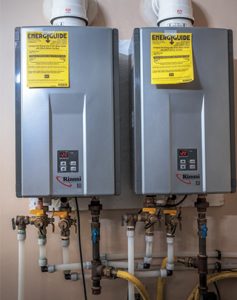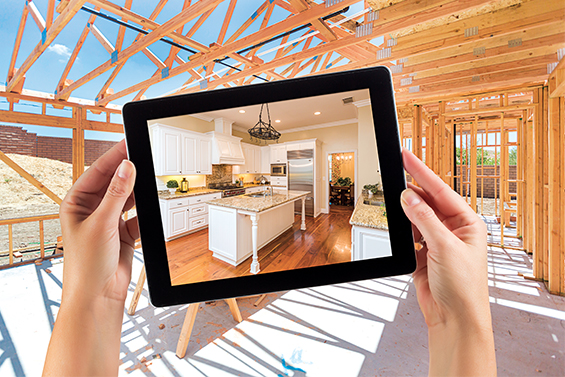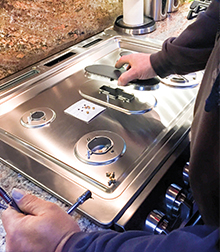Improving residential and commercial properties with propane

Photo courtesy of Outdoor Order and Blossman Gas
Consistently shifting from a bygone role as wintertime order takers to assertive year-round marketers, propane’s possibilities as a trending go-to fuel still depend upon the industry’s ability to effectively spread the word about its fuel.
This pertains especially to your local business – letting consumers know that propane has an economical, clean-burning place in the home, in the yard, on the road and at work or school.
“We have to reach out to our specific markets and educate them on everything propane can do,” urges Dan Richardson, president and CEO of Tifton, Georgia-based Conger LP Gas, which has been leveraging initiatives from the Propane Education & Research Council (PERC) to actively pursue growing load in the residential and commercial segments.
“Rather than going after another company’s tanks, we’re trying to find new applications,” he explains. “We’re working hard to reach out to more contractors and homeowners; we’ve already done a home show, and we’re going to do another one to further reach out to contractors and the public.”
Conger LP Gas recently inked a preliminary pact to supply propane to an entire industrial park coming into town.
“We’d use meters at all the businesses,” Richardson reports. “It could be very big for us if it works out. We’re working full-speed ahead to make it happen. The city and county leaders that we’re working with are very excited about using propane in their industrial park.”
Richardson’s marketing sphere is markedly rural, and the area’s natural gas utility is not interested in putting in additional piping. Government officials were initially faced with the prospect of telling prospective industrial park tenants that gas service was not to be had.
“But now they can tell them that gas is available with propane, and we can move fast to make it happen,” Richardson says. “We can get everything done in 90 days.”

Propane-powered outdoor amenities extend the outdoor living season in regions with seasonal temperature fluctuations. Photo courtesy of Blossman Gas and iStock.com/oneilbro
Builder engagement
The residential and commercial markets will continue to see modest improvements over the next three years as the overall economy stabilizes and buyer confidence increases, according to Jesse Marcus, PERC’s director of residential and commercial business development.
“Given the overarching market trends in the residential and commercial markets, it is more important than ever to continue to target those individuals and organizations that are critical to the specification of propane and propane applications in homes, commercial facilities and on job sites,” he notes in an email to LP Gas. “These individuals and organizations include builders, general contractors, architects, engineers, plumbers and HVAC contractors, among others.”
PERC’s plans include targeted outreach regarding zero net energy and propane’s value in green building, national builder engagement and the use of propane in the major appliance areas in new construction specific to developments and communities, regional and custom builders outreach, electric water heater replacement – especially when there is already propane in the home – outdoor amenities in regions where extending the outside living season is reasonable, and regaining market share in manufactured and modular housing.
“The commercial market, with varying types of infrastructure and associated needs, tends to be more diverse in customer type and decision-maker (when compared to potential residential clients),” Marcus notes. “Identifying the explicit needs of each building type and addressing the decision-maker audiences, along with combating the inclusion of electric systems in commercial buildings, will remain a focus in 2019.”
Accounting for about 20 percent of propane’s annual load, commercial demand is less affected by weather than the residential sector, which helps explain why market share has remained somewhat stable during warm and cold winters alike, he points out.
There were more than 9.6 million commercial buildings in the U.S. in 2012 – a 14 percent increase from 2003, PERC says. Commercial fuel consumption increased 7 percent from 2003 to 2012.

Propane-powered space heaters and fireplaces are among the significant sellers for businesses and higher-end homes. Photo courtesy of Empire Comfort Systems and Blossman Gas
“Over that period, buildings using electricity saw a total fuel usage increase of 19 percent, where buildings using propane saw their total fuel usage decline by 12 percent over the same period,” Marcus explains. “However, the number of commercial businesses that use propane increased by 17 percent in that same time frame.”
Throughout 2019, the nation is expected to experience nearly 1.35 million housing starts, PERC notes.
“This is somewhat of a slower pace than previously predicted, and with that pace, housing demand will continue to exceed supply through 2022,” Marcus notes. “This will lead to significantly higher remodeling activity with quarter-over-quarter improvements throughout 2019 and beyond.”
Additional factors that will positively impact this segment include availability of land for development outside of natural gas distribution lines, a normalization of mortgage rates, decreased unemployment rates (3.9 percent as of June 2018) and increased consumer confidence, Marcus adds.
“As one of the largest consumer segments, millennials will dominate renovation activity. While being generally priced out of the new construction market, they will be heavily engaged in the resale and remodeling market,” he states. “So, targeting these influencers is critical.”

Tankless water heaters are a growing trend in the residential propane market. Photo courtesy of the Propane Education & Research Council
Propane-heated households are beginning to rebound from the declines experienced from 2006 to 2012, when the figures slipped from 6.46 million to 5.54 million, PERC reports.
“Both the New England and Middle Atlantic regions are seeing growth in propane-heated homes due to fuel oil conversions and new construction,” Marcus notes. “While total propane space heating households have increased slowly since 2012, propane-heated homes have not kept pace with new construction growth, where electric has been dominant.”
In the South Atlantic region, propane’s share declined from 2.7 percent to 0.65 percent as electricity achieved new-construction prominence. East North Central, West North Central, Mountain and Pacific have experienced stable or rising market share since 2012. Yet in the South Atlantic, East South Central and West South Central, the downward trend that began in 2006 has continued, according to Marcus.
Propane water heating increased from 4.2 million to 4.6 million households, a market-share increase from 3.6 percent in 2005 to 3.9 percent in 2015.
However, this growth is largely confined to two regions, the Northeast and the Midwest, Marcus reports. The Northeast has experienced the largest growth, increasing from 300,000 to 1 million households. The highest category market share – 5.7 percent in 2015, up from 5 percent in 2009 – is found in the Midwest, where there are 1.5 million propane-water-heated households.

New homeowners have a variety of propane applications from which to choose. Photo: iStock.com/Feverpitched
One-stop service
“For us, the growth trend is coming in tankless water heaters; 38 percent of the tankless water heaters that we’re installing are replacing electric water heaters,” says Richardson at Conger LP Gas in Georgia.
Manufacturer support is an important aspect of the sales push.
“We talked to Rinnai and told them we wanted to move more. We sold 145 last year, and this year our goal is to do 250. After six months, we’re halfway there,” he reports.
The units are a popular residential and commercial mainstay at Blossman Gas.
“Tankless water heaters really save our customers in operating costs,” says Kim Reynolds, a commercial account representative at Blossman Gas. “It’s incumbent on the propane industry to get that message out there.”
In March, PERC rolled out an upgraded Propane Construction Incentive Program. Builders and remodelers now have the option to incorporate just three propane applications into projects during 2018 to be eligible for its incentives, which offer four levels of packages ranging between $500 and $1,500.
“Last year, more than 120 builders took advantage of our incentive program to construct 300 new homes and install more than 1,000 propane appliances, and the new incentive packages will help even more builders and remodelers turn to propane as a solution in 2018,” according to Marcus.

Kitchen appliances are another way to add gallons in the residential market.
Photo: iStock.com/Bill Oxford
The eligibility levels are based on PERC’s Propane Energy Pod model, an integrated, whole-home energy upgrade that includes using propane for space heating, water heating, cooking, fireplaces, clothes drying and standby power. The newest “basic package” level offers builders $500 for including any new propane water heating system and two additional propane applications.
Incentive packages increase in level up to $1,500 per home for builders or remodelers installing more propane applications.
At Blossman Gas, Reynolds says, “We offer full service for all those needs.”
The company provides advice on proper equipment sizing, sales, installation, service and all of the propane needed to supply a residential or commercial account.
“Probably the most popular trend I’m seeing with commercial properties is the enhancement of outdoor spaces,” says Reynolds, referring to hospitality-industry patios that can allow these amenities “to be not-so-seasonal – providing comfortable outdoor spaces so revenue can be generated throughout the year.”
Space heaters for colder temperatures and atmospheric-type fireplaces that produce a minimum amount of heat for warmer environments are among the significant sellers.
“You can still enjoy a fireplace, but it’s not running you out of the room,” Reynolds says.
Pushing construction professional toward propane

Construction professionals and remodelers can take PERC’s Propane Training Academy course for free. PHOTO COURTESY OF THE PROPANE EDUCATION & RESEARCH COUNCIL
PERC’s Propane Training Academy has unveiled a new online course that provides remodelers and other construction professionals with an overview of home remodeling trends and how innovative propane technologies can add value to remodeling projects.
The online course, “Adding Value and Innovation to Remodeling Projects with Propane: Opportunities to Leverage High Performance Propane Systems,” will count toward continuing education credits from the American Institute of Architects, National Association of Home Builders, National Association of the Remodeling Industry and the U.S. Green Building Council.
Construction professionals can take the course for free. Upon completion, attendees will understand:
- Current remodeling industry market trends based on industry research data.
- The most common remodeling projects based on industry data.
- How to integrate propane technologies to add value and performance to a remodeling project.
- The options for integrating propane storage into a home.“Propane applications are consistently improving in their versatility and effectiveness, and our new course helps remodelers and construction professionals stay up to speed on the growing number of cost-effective and resilient home applications afforded by propane technologies,” says JesseMarcus, PERC’s director of residential and commercial business development. “Propane appliances can be integrated throughout the home and greatly enhance the outcome of a remodeling project for customers of construction professionals.”
















